Dried Spices Market Research, 2032
The global dried spices market was valued at $10.7 billion in 2022, and is projected to reach $16.6 billion by 2032, growing at a CAGR of 4.6% from 2023 to 2032. Dried spices undergo a dehydration process to eliminate their water content. This dehydration procedure aids in maintaining the taste, fragrance, and shelf life of the spices for an extended period. Dehydration can be accomplished through different techniques, such as natural sunlight drying, or other specific dehydrating processes. After the moisture is eliminated, the resulting dried spices usually have a more intense form, simplifying their storage and utilization in various applications. The intensified flavor of dried spices enhances the overall culinary experience, allowing for the creation of more flavorful and aromatic dishes. This is particularly advantageous for chefs, home cooks, and food manufacturers who seek to impart distinct flavors to their recipes.
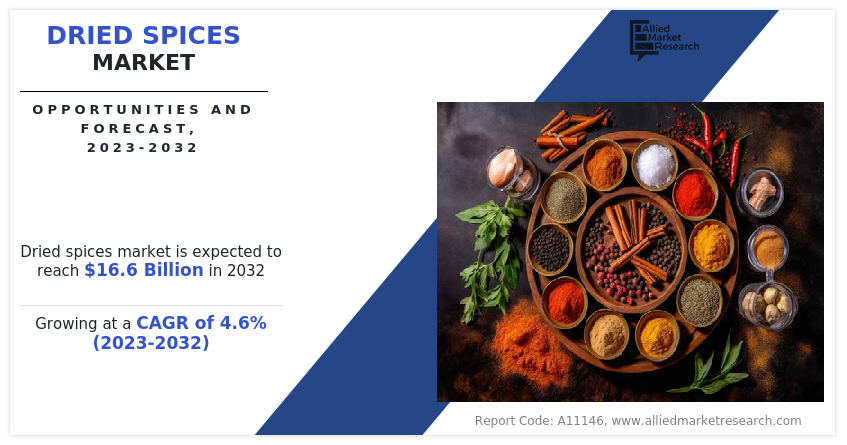
Market Dynamics
The dried spices market has experienced significant growth driven by the increasing awareness regarding the health benefits associated with dried spice consumption. Dried spices, including turmeric, cinnamon, and ginger, are recognized for their antioxidant properties, anti-inflammatory effects, and positive impacts on digestive health. These health-promoting attributes match well with the health-conscious consumers seeking functional food, and thus the manufacturers are utilizing such ingredients in the manufacturing of functional foods, which, in turn, is driving the growth of the dried spices market size. The demand is further fueled by the rising trend of healthy living and self-care and prevention methods such as weight management, blood sugar regulation, and immune system support, with spices such as garlic and cayenne pepper playing a major role in helping reduce these health problems. The nutrient density of dried spices, coupled with their ability to enhance the flavor profile of dishes with minimal calories, appeals to the health and wellness preferences of consumers. As a result, the dried spices market has witnessed rapid growth as consumers increasingly prioritize health benefits in their food choices, creating numerous opportunities for businesses in the dried spices industry.
In addition, dried spices have become an integral part of the cooking experience that is driven by an increase in remote work and home-based culinary activities. As per Forbes Advisor, the current trend highlights a shift in work dynamics, with 12.7% of full-time employees opting for remote work, indicating the swift integration of virtual work environments. Moreover, 28.2% of workers have adopted a hybrid work model, which blends remote and in-office work. As a result, the convenience of working from home has allowed individuals to invest more time and effort in preparing meals, which has led to a growing interest in diverse and flavorful home-cooked dishes. Dried spices play a pivotal role, offering a convenient and versatile solution to enhance the taste of homemade meals. Furthermore, the easy accessibility of dried spices in retail outlets makes them a preferred choice for individuals seeking to enjoy their cooking without extensive preparation. Thus, this trend of preparing a variety of dishes from different cuisines is significantly supported by the availability of international recipes and cooking inspirations on social media. The increased demand for dried spices reflects changing food preferences and lifestyle choices brought about by the work-from-home trend in the past few years. As individuals find fulfillment in preparing delicious meals within the comfort of their homes, the dried spices market share has experienced a rapid growth in recent years globally.
Although the dried spices market has expanded rapidly, the market still faces certain challenges owing to the presence of counterfeit products and color-added products. According to EU Council notes, the global food industry incurred an estimated cost of approximately $32.91 billion per year due to fraudulent practices in 2019. The Consumer Brands Association (CBA) has provided additional insights, suggesting that food fraud may impose a financial burden of $10-15 billion annually on the global food industry, impacting around 10% of all food products sold. However, in the dried spices market, these counterfeit products may imitate popular brands or types of dried spices, misleading consumers about the authenticity and quality of the product. The counterfeit items further contain substandard or unrelated ingredients, posing health risks and eroding consumer trust. In some cases, artificial colors are added to dried spices to enhance visual appeal or mask quality issues, which hampers the likeliness of the market. The use of such additives is a concern for consumers seeking natural and unadulterated products. The presence of undisclosed ingredients, including artificial colors, can have implications for consumer health. Some individuals may have allergies or sensitivities to certain additives, making it crucial for accurate labeling. Thus, the presence of counterfeit products is expected to hinder the global dried spices market growth.
The growth in demand for organic spices products has created numerous opportunities for the market players in the dried spices market in recent times. According to the results released by the U.S. Department of Agriculture’s National Agricultural Statistics Service (NASS), the 2021 Organic Survey indicates total sales of $11.2 billion in organic products, reflecting a $1.28 billion, or 13%, increase from 2019. As a result, the perception of organic dried spices as healthier substitutes has gained significant recognition among consumers owing to their cultivation without the utilization of artificial pesticides, fertilizers, or genetically modified organisms (GMOs). Furthermore, governmental and regulatory bodies across different regions are actively endorsing and supporting the adoption of organic farming practices. This is expected to provide dried spices manufacturers with a favorable regulatory environment for the production and marketing of organic dried spices. The increased emphasis on compliance with organic certifications by dried spices producers is expected to enhance the credibility of products in the eyes of consumers, thus driving the dried spices market demand in the coming years.
Segmental Overview
The dried spices market is analyzed on the basis of source, product type, form, application, and region. By source, the market is bifurcated into natural and organic. By product type, the market is segmented into pepper, ginger, cinnamon, cumin, turmeric, cardamom, cloves, nutmeg & mace, and others. Depending on form, it is classified into powder, granules, and whole. By application, the market is divided into food and beverage industry, foodservice industry, and retail. Region wise, the market is analyzed across North America (the U.S., Canada, and Mexico), Europe (Germany, the UK, France, Spain, Italy, and the rest of Europe), Asia-Pacific (China, India, Japan, South Korea, Indonesia, Thailand, Malaysia, Vietnam, and the rest of Asia-Pacific), and LAMEA (Brazil, South Africa, UAE, Argentina, and the rest of LAMEA).
By Source
By source, the natural segment dominated the global dried spices market in 2022 and is anticipated to maintain its dominance during the forecast period. Consumers opt for natural dried spices due to their cost-effectiveness, wide availability, and adherence to culinary traditions. Natural dried spices are often more affordable than their organic counterparts, which helps this segment to gain significant share in the dried spices market. Moreover, natural dried spices are more widely available in supermarkets and grocery stores. This increased accessibility makes it convenient for consumers to find and purchase these dried spices easily. In addition, limited awareness or understanding of the distinctions between conventional and organic options, coupled with specific spice varieties only available in natural form, also influence purchasing decisions of consumers during the dried spices market forecast.
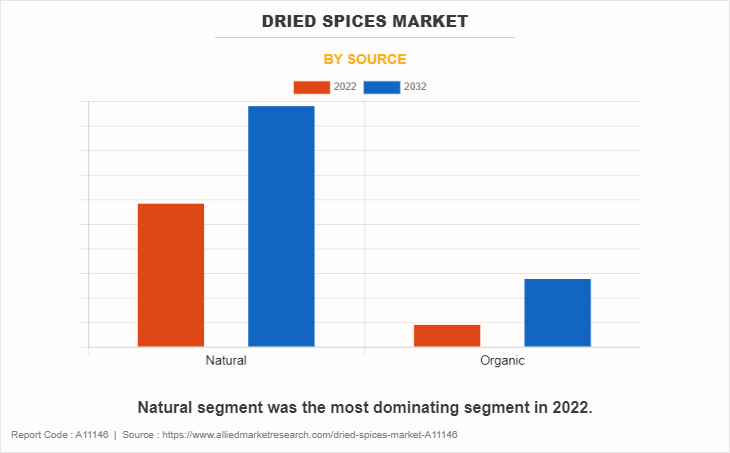
By Product Type
By product type, the pepper segment dominated the global dried spices market in 2022 and is anticipated to maintain its dominance during the forecast period. Dried pepper products offer convenience and an extended shelf life compared to fresh peppers. They are easy to store and have a longer durability, making them a practical choice for consumers. Moreover, the popularity of various international cuisines has risen, and many global dishes incorporate dried peppers as a staple ingredient. This increased interest in diverse culinary experiences contributes to the demand for dried pepper products. In addition, peppers are known for their health benefits owing to the presence of antioxidants and other nutrients. Dried peppers retain these nutritional elements, and the perception of them being a healthy addition to meals is expected to drive the growth of this segment.
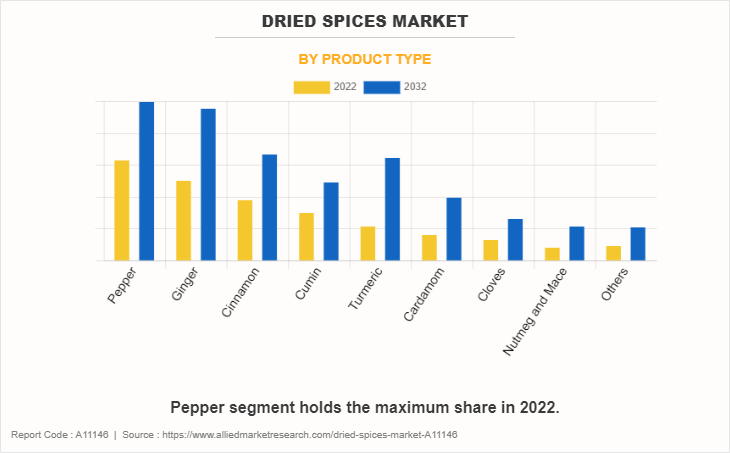
By Form
By form, the powder segment dominated the global dried spices market in 2022 and is anticipated to maintain its dominance during the forecast period. Powdered spices offer unparalleled convenience and ease of use in culinary applications, eliminating the need for chopping or grinding. This pre-processing enhances efficiency for both households and foodservice industries. Moreover, powdered spices boast an extended shelf life, ensuring longer product durability compared to their whole counterparts. This longevity aligns with consumer preferences for pantry-staple items. The fine texture of powdered spices facilitates uniform flavor distribution in dishes, enhancing the overall taste experience. In addition, manufacturers often invest in advanced technologies to ensure consistent quality, contributing to the widespread consumer preference and dominance of the powdered dried spices segment.
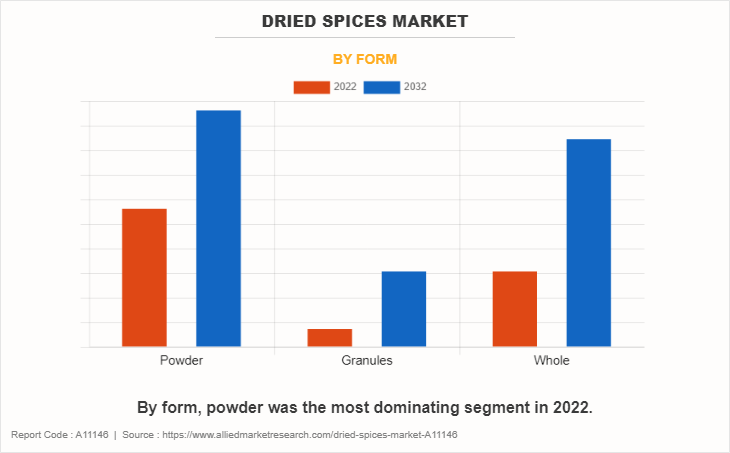
By Application
By application, the food and beverage industry segment dominated the global dried spices market in 2022. Dried spices are fundamental for enhancing the flavor profiles of food and beverage products. They add depth, complexity, and distinctive tastes to a wide range of dishes and beverages, which drives the demand for dried spices in this segment. Moreover, dried spices allow manufacturers to differentiate their products in a crowded market. Unique spice blends or the use of specific spices can give a product a distinct identity and set it apart from competitors. In addition, dried spices are essential for achieving authentic and traditional flavors in various cuisines. They enable food and beverage manufacturers to replicate regional and cultural tastes, meeting consumer expectations for genuine culinary experiences. Dried spices are versatile ingredients applicable to a wide array of food and beverage categories. They are used in savory dishes, snacks, baked goods, beverages, and sauces, offering flexibility in product development. Furthermore, some dried spices such as pepper, turmeric, and cinnamon are associated with health benefits, and their incorporation into food and beverages aligns with consumer trends focused on wellness and functional ingredients.
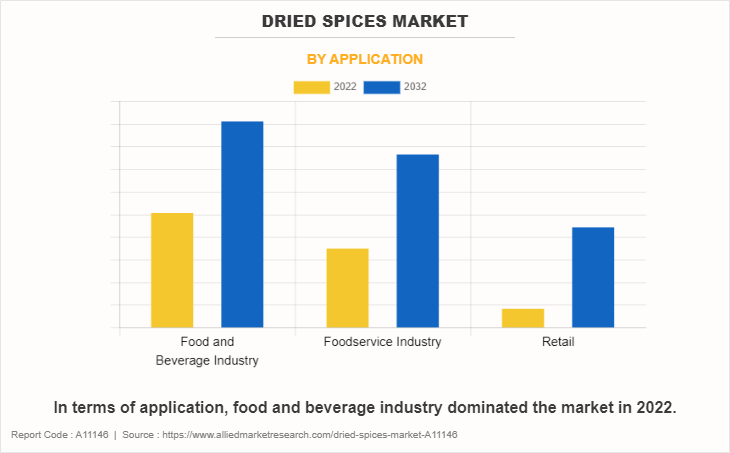
By Region
Region wise, Asia-Pacific is anticipated to dominate the market with the largest share during the forecast period. The expanding population in the region contributes to a substantial demand for dried spices in the region. With a large consumer base and a strong culinary culture, the consumption of spices in everyday cooking is widespread. Moreover, dried spices hold significant cultural importance in many Asian countries. They are often deeply ingrained in culinary traditions, rituals, and celebrations, leading to consistent demand across households and commercial food establishments.
Some countries in the region such as India, China, Indonesia, Vietnam, and Thailand have favorable climates for spice cultivation, allowing for huge production of dried spices. The proximity of spice-producing regions to major consumer markets in the region further supports the availability and affordability of dried spices, thus increasing the growth of the dried spices market. Furthermore, governments actively support and promote spice cultivation as part of agricultural initiatives, contributing to increased production and market share of dried spices in Asia-Pacific.
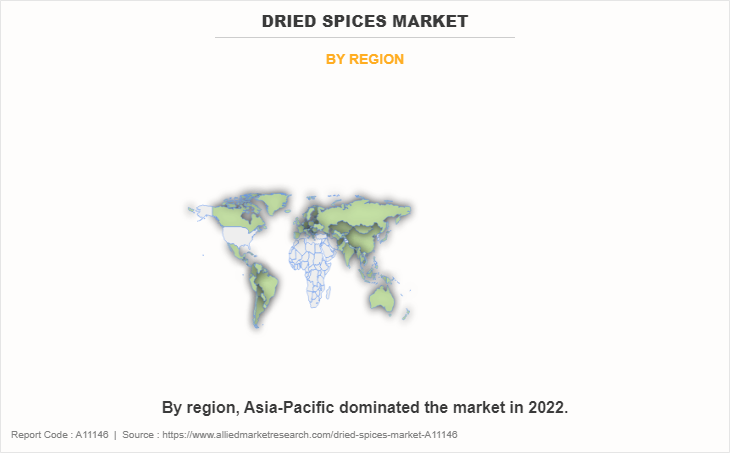
Competitive Landscape
The key players include Everest Food Products Pvt. Ltd., McCormick & Company, Inc., Bart Ingredients Company Ltd., DS Group, Firmenich SA, Olam Group Limited, The Spice House, Simply Organic, Sauer Brands, and Frontier Co-op.
Several well-known and up-and-coming brands are vying for market dominance in the expanding dried spices industry. Smaller, niche firms have become more well-known for catering to particular consumer demands and tastes. Large conglomerates, however, still control the majority of the market and frequently buy creative start-ups to broaden their product lines.
Private label brands created by merchants and e-commerce platforms are another aspect of the competitive market. While they provide more affordable options, they might have different recognition or range of products than‐¯well-known companies. An important competition component‐¯is innovation in formulations, ingredient sourcing, and sustainability policies. Brands that are able to change‐¯the tastes of their target market and align with their ethical and environmental values have an advantage over rivals.
Key Benefits for Stakeholders
- This report provides a quantitative analysis of the market segments, current trends, estimations, and dynamics of the dried spices market analysis from 2022 to 2032 to identify the prevailing dried spices market opportunities.
- The market research is offered along with information related to key drivers, restraints, and opportunities.
- Porter's five forces analysis highlights the potency of buyers and suppliers to enable stakeholders make profit-oriented business decisions and strengthen their supplier-buyer network.
- In-depth analysis of the dried spices market segmentation assists to determine the prevailing market opportunities.
- Major countries in each region are mapped according to their revenue contribution to the global market.
- Market player positioning facilitates benchmarking and provides a clear understanding of the present position of the market players.
- The report includes the analysis of the regional as well as global dried spices market trends, key players, market segments, application areas, and market growth strategies.
Dried Spices Market Report Highlights
| Aspects | Details |
| Forecast period | 2022 - 2032 |
| Report Pages | 190 |
| By Source |
|
| By Product Type |
|
| By Form |
|
| By Application |
|
| By Region |
|
Analyst Review
The perspectives of the leading CXOs in the dried spices industry are presented in this section. Rising consumer interest in healthy eating, global cuisine, and convenience cooking fuels the demand for diverse and readily available dried spices. Moreover, rise in awareness of regional flavors and culinary exploration drives the market for specialty and exotic spices.
The growing interest in organic and sustainable dried spices products is one of the significant trends for market growth. Brands are being driven to produce organic dried spices as consumers' awareness regarding the benefits of the organic dried spices market over conventional ones grows. Recyclable packaging and natural and organic products have grown in popularity. In addition, convenient packaging formats such as single serve pods, blends, and recipe kits cater to busy lifestyles and changing consumer preferences, which helps drive the demand for dried spices market.
The dried spices industry has further seen a digital transition, with e-commerce being a key factor. Online platforms provide wider reach and access to a global consumer base, bypassing traditional distribution channels. Consumers can now acquire a variety of dried spices more easily due to online sales channels, and other e-commerce sites. Social media sites are developed into effective marketing tools that enable firms to interact directly with their target audience. Thus, all such factors are expected to boost the dried spices market growth.
The global dried spices market was valued at $10.7 billion in 2022, and is projected to reach $16.6 billion by 2032
The global Dried Spices market is projected to grow at a compound annual growth rate of 4.6% from 2023 to 2032 $16.6 billion by 2032
The key players include Everest Food Products Pvt. Ltd., McCormick & Company, Inc., Bart Ingredients Company Ltd., DS Group, Firmenich SA, Olam Group Limited, The Spice House, Simply Organic, Sauer Brands, and Frontier Co-op.
Region wise, Asia-Pacific is anticipated to dominate the market with the largest share during the forecast period.
Increase in awareness regarding the health benefits associated with spice consumption, Expansion of food service industry, Increase in remote work culture and home-based culinary activities
Loading Table Of Content...
Loading Research Methodology...



